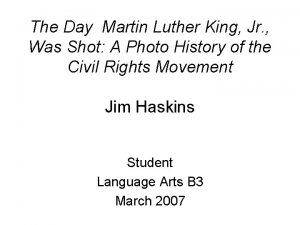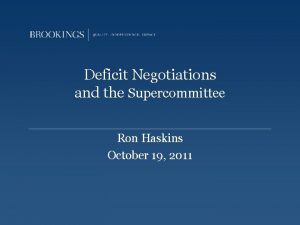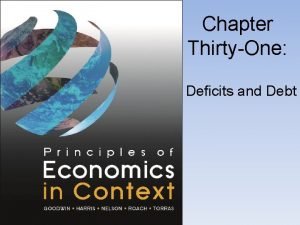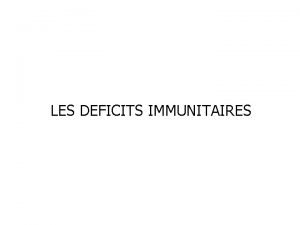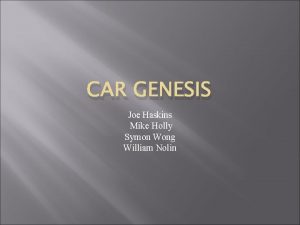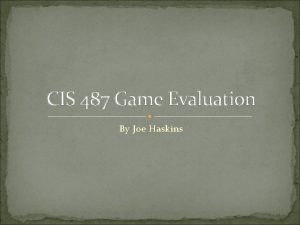1 2 Deficits and Disaster Ron Haskins The
































- Slides: 32

1

2 Deficits and Disaster Ron Haskins The Brookings Institution September 14, 2010 Thanks to Isabel Sawhill, Alex Gold, Daniel Moskowitz and Mary Baugh.

3 Overview • • Big Picture Polls/Public Dialogue Why Deficits Matter Taking Action

4 The Big Picture I: Budget Projections Actual CBO Baseline (August 2010) Adjusted Baseline Sources: Actual is from Office of Management and Budget Historical Tables (http: //www. whitehouse. gov/sites/default/files/omb/budget/fy 2011/assets/hist 01 z 1. xls); CBO Baseline is from “The Budget and Economic Outlook: An Update, ” August 2010 (http: //www. cbo. gov/ftpdocs/117 xx/doc 11705/08 -18 -Update. pdf); Adjusted Baseline is from Auerbach and Gale, “Déjà Vu All Over Again: On the Dismal Prospects for the Federal Budget, ” 2010 (http: //www. brookings. edu/~/media/Files/rc/papers/2010/0429_budget_outlook_gale. pdf).

5 The Big Picture II: Spending and Debt as Percent of GDP, 2010, 2020, 2050 Note: The Medicare category is net of Medicare premiums and payments. Source: Congressional Budget Office, Alternative Fiscal Scenario, The Long Term Budget Outlook, June 2010.

6 The Big Picture III: Rising Debt/GDP Ratio Source: Congressional Budget Office, Alternative Fiscal Scenario, The Long Term Budget Outlook, June 2010.

7 The Big Picture IV: Unsustainable Spending Sources: Congressional Budget Office, “Historical Budget Data” (http: //www. cbo. gov/ftpdocs/108 xx/doc 10871/Appendix. F. shtml) and Congressional Budget Office, Alternative Fiscal Scenario, The Long Term Budget Outlook, June 2010.

8 Polls: The Deficit Is Top Priority Source: Pew Research Center for the People & the Press, various years.

9 Polls: Public Worried About Deficits Source: Gallup, March 4 -7, 2010.

10 Polls: Public Support for Sacrifice Willing to pay higher taxes Willing to decrease spending on health care or education Source: Rasmussen, April 27 -28, 2010. Source: CBS News / New York Times Poll, February 2010. Willing to decrease military spending Source: CBS News / New York Times Poll, February 2010.

11 Polls: Willingness to Cut Specific Programs Source: The Economist / You. Gov Poll, April 3 -6, 2010.

12 Polls: Support for Specific Solutions Source: Bloomberg Poll, December 2009.

13 Good News: Attitudes Change in Response to Dialogue • Dialogues with public on Social Security, Medicare, and taxes • Conducted by Viewpoint Learning in collaboration with other organizations • 12 day-long dialogues all over the country • Representative sample of 35 -45 participants

14 Dialogues with the Public: Medicare – 68% support gradually raising the age of – – eligibility from 65 to 67 68% support progressive scaling of premiums to income 79% support raising taxes to maintain benefit levels 75% support a 2 -3% national sales tax 63% support raising the payroll tax rate

15 Dialogues with the Public: Taxes • Participants are willing to pay higher taxes if they are sure that their tax dollars are well spent for reducing deficit or for earmarked purposes they consider important. • 57% support raising taxes to reduce the deficit • 67% support investment in education and transportation even if taxes increase

16 Why Deficits Matter • • • Dependence on foreign lenders Rapidly rising interest costs Burden on future generations Limited ability to invest in children Limited ability to address emergencies

17 Dependence on Foreigners Source: U. S. Treasury Department and U. S. Bureau of Public Debt (though June 2009).

18 Rapidly Rising Interest Costs Source: Congressional Budget Office, “The Budget and Economic Outlook: An Update, ” August 2010, Table 1 -2, (http: //www. cbo. gov/ftpdocs/117 xx/doc 11705/Budget. Projections. xls).

19 Burden on Future Generations

20 Spending On Children and The Elderly Source: Julia B. Isaacs, How Much Do We Spend on Children and the Elderly (Washington, D. C. : Brookings, 2009).

21 Productive Investments in Children • • Preschool Education Home Visiting Teen Pregnancy Prevention Career Academies K-12 Education, Especially KIPP Schools Second Chance Programs for Teens Community and Family-based Programs for Delinquents • Community College Interventions • Small Schools of Choice

22 Limited Ability to Address Emergencies • Wars and Terrorists Attacks • Natural Disasters • Recessions

23 Taking Action: Preconditions • Public recognition that deficits are a problem • Public willingness to pay new taxes and accept spending cutbacks • Everything on the table • Bipartisanship • Presidential Leadership

24 Taking Action: General Rules • Recognition of short-term vs. long-term impacts • Combination of spending cuts and revenue incentives • No implementation until economy is in recovery • Implement cuts gradually over a period of years • Savings must come from big three entitlements: Medicare, Medicaid, and Social Security

25 Average Number of Years Spent in Retirement: 1950 and 2006 Source: Isabel V. Sawhill, “Paying for Investments in Children, ” in Big Ideas for Children: Investing in Our Nation’s Future, edited by First Focus (Washington, D. C. : First Focus, 2008).

26 Selected Statistics for the Elderly and Non-Elderly Source: Isabel V. Sawhill, “Paying for Investments in Children, ” in Big Ideas for Children: Investing in Our Nation’s Future, edited by First Focus (Washington, D. C. : First Focus, 2008); updated with data for 2007 where available.

27 Taking Action: Social Security Reforms Source: Congressional Budget Office, “Summary Figure 1, ” in Social Security Policy Options, summary (2010).

28 Taking Action: Health Care Reform • • • Is Obama reform the solution or part of the problem? New costs – Guaranteed access to a basic package – Subsidies related to income; Medicaid expansion – The Class Act Offsets to costs – Taxation of high-end plans – Medicare cuts – Employer and individual fees for not participating – “Bending the curve” (e. g. , IT, evidence-based medicine, more coordination, Medicare Commission) But very unlikely that we can restrain costs enough to prevent growth of government or reduce current projected deficits Two possible choices – Caps on spending (implicit rationing) – A new source of revenue to cover cost; e. g. , VAT

29 Taking Action: Four Revenue Options • Increase income tax rates • Broaden the income tax base (reduce tax expenditures) • Increase energy taxes • Impose consumption taxes Source: William Gale, Brookings Institution, 2010.

30 Cost of Selected Tax Expenditures: Average Annual Cost (2009 -2013) Tax Expenditure Average Cost (billions) Deduction for mortgage interest $114. 58 Exclusion of employer contributions for health care $113. 64 Reduced rates of tax on dividends and long-term capital gains $83. 76 Credit for children under age 17 $32. 06 Exclusion of capital gains at death $31. 88 Exclusion of investment income on life insurance and annuity contracts for insurance companies $31. 78 Deduction for property taxes on real property $25. 14 Exclusion of Medicare supplementary medical insurance (Part B) $23. 94 Exclusion on capital gains on sales of principal residences $17. 32 Credit for alcohol fuels $8. 38 Exclusion of Medicare prescription drug insurance (Part D) $5. 76 Exclusion of employer-paid transportation benefits $4. 30 Source: Joint Committee on Taxation, “Table 1: Tax Expenditure Estimates By Budget Function, Fiscal Years 2009 -2013, ” in Estimates of Federal Tax Expenditures for Fiscal Years 2009 -2013 (Washington, D. C. : Author, 2010).

31 Class Act • Long-term care insurance • Short-term savings (2010 -2019): $57. 8 billion • Long-term costs: – Adverse selection – CBO: “The program would add to future federal budget deficits in a large and growing fashion. ”

32
 Ortal lieberman
Ortal lieberman The day martin luther king jr was shot by jim haskins
The day martin luther king jr was shot by jim haskins Hình ảnh bộ gõ cơ thể búng tay
Hình ảnh bộ gõ cơ thể búng tay Slidetodoc
Slidetodoc Bổ thể
Bổ thể Tỉ lệ cơ thể trẻ em
Tỉ lệ cơ thể trẻ em Gấu đi như thế nào
Gấu đi như thế nào Chụp phim tư thế worms-breton
Chụp phim tư thế worms-breton Alleluia hat len nguoi oi
Alleluia hat len nguoi oi Môn thể thao bắt đầu bằng chữ đua
Môn thể thao bắt đầu bằng chữ đua Thế nào là hệ số cao nhất
Thế nào là hệ số cao nhất Các châu lục và đại dương trên thế giới
Các châu lục và đại dương trên thế giới Công thức tiính động năng
Công thức tiính động năng Trời xanh đây là của chúng ta thể thơ
Trời xanh đây là của chúng ta thể thơ Mật thư tọa độ 5x5
Mật thư tọa độ 5x5 Làm thế nào để 102-1=99
Làm thế nào để 102-1=99 Phản ứng thế ankan
Phản ứng thế ankan Các châu lục và đại dương trên thế giới
Các châu lục và đại dương trên thế giới Thơ thất ngôn tứ tuyệt đường luật
Thơ thất ngôn tứ tuyệt đường luật Quá trình desamine hóa có thể tạo ra
Quá trình desamine hóa có thể tạo ra Một số thể thơ truyền thống
Một số thể thơ truyền thống Cái miệng xinh xinh thế chỉ nói điều hay thôi
Cái miệng xinh xinh thế chỉ nói điều hay thôi Vẽ hình chiếu vuông góc của vật thể sau
Vẽ hình chiếu vuông góc của vật thể sau Thế nào là sự mỏi cơ
Thế nào là sự mỏi cơ đặc điểm cơ thể của người tối cổ
đặc điểm cơ thể của người tối cổ Ví dụ về giọng cùng tên
Ví dụ về giọng cùng tên Vẽ hình chiếu đứng bằng cạnh của vật thể
Vẽ hình chiếu đứng bằng cạnh của vật thể Vẽ hình chiếu vuông góc của vật thể sau
Vẽ hình chiếu vuông góc của vật thể sau Thẻ vin
Thẻ vin đại từ thay thế
đại từ thay thế điện thế nghỉ
điện thế nghỉ Tư thế ngồi viết
Tư thế ngồi viết Diễn thế sinh thái là
Diễn thế sinh thái là

